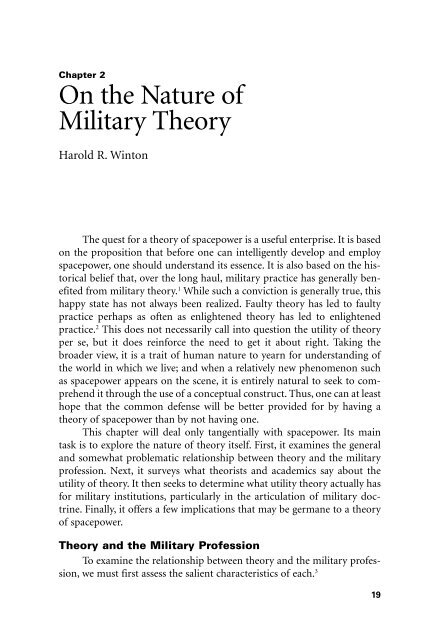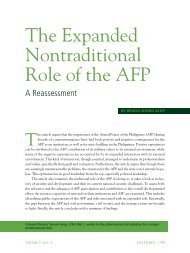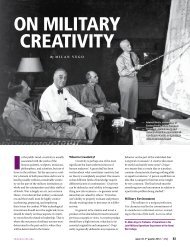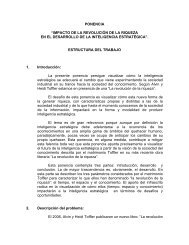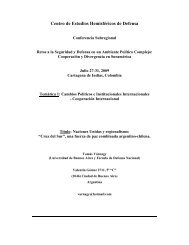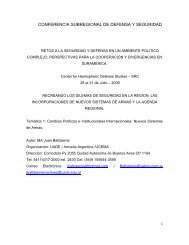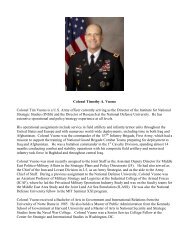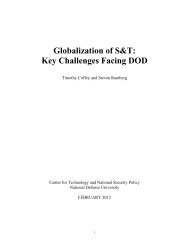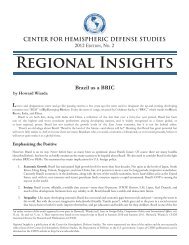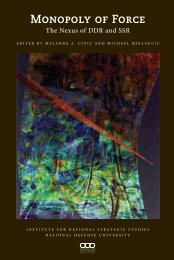On the Nature of Military Theory - National Defense University
On the Nature of Military Theory - National Defense University
On the Nature of Military Theory - National Defense University
Create successful ePaper yourself
Turn your PDF publications into a flip-book with our unique Google optimized e-Paper software.
Chapter 2<br />
<strong>On</strong> <strong>the</strong> <strong>Nature</strong> <strong>of</strong><br />
<strong>Military</strong> <strong>Theory</strong><br />
Harold R. Winton<br />
The quest for a <strong>the</strong>ory <strong>of</strong> spacepower is a useful enterprise. It is based<br />
on <strong>the</strong> proposition that before one can intelligently develop and employ<br />
spacepower, one should understand its essence. It is also based on <strong>the</strong> historical<br />
belief that, over <strong>the</strong> long haul, military practice has generally benefited<br />
from military <strong>the</strong>ory. 1 While such a conviction is generally true, this<br />
happy state has not always been realized. Faulty <strong>the</strong>ory has led to faulty<br />
practice perhaps as <strong>of</strong>ten as enlightened <strong>the</strong>ory has led to enlightened<br />
practice. 2 This does not necessarily call into question <strong>the</strong> utility <strong>of</strong> <strong>the</strong>ory<br />
per se, but it does reinforce <strong>the</strong> need to get it about right. Taking <strong>the</strong><br />
broader view, it is a trait <strong>of</strong> human nature to yearn for understanding <strong>of</strong><br />
<strong>the</strong> world in which we live; and when a relatively new phenomenon such<br />
as spacepower appears on <strong>the</strong> scene, it is entirely natural to seek to comprehend<br />
it through <strong>the</strong> use <strong>of</strong> a conceptual construct. Thus, one can at least<br />
hope that <strong>the</strong> common defense will be better provided for by having a<br />
<strong>the</strong>ory <strong>of</strong> spacepower than by not having one.<br />
This chapter will deal only tangentially with spacepower. Its main<br />
task is to explore <strong>the</strong> nature <strong>of</strong> <strong>the</strong>ory itself. First, it examines <strong>the</strong> general<br />
and somewhat problematic relationship between <strong>the</strong>ory and <strong>the</strong> military<br />
pr<strong>of</strong>ession. Next, it surveys what <strong>the</strong>orists and academics say about <strong>the</strong><br />
utility <strong>of</strong> <strong>the</strong>ory. It <strong>the</strong>n seeks to determine what utility <strong>the</strong>ory actually has<br />
for military institutions, particularly in <strong>the</strong> articulation <strong>of</strong> military doctrine.<br />
Finally, it <strong>of</strong>fers a few implications that may be germane to a <strong>the</strong>ory<br />
<strong>of</strong> spacepower.<br />
<strong>Theory</strong> and <strong>the</strong> <strong>Military</strong> Pr<strong>of</strong>ession<br />
To examine <strong>the</strong> relationship between <strong>the</strong>ory and <strong>the</strong> military pr<strong>of</strong>ession,<br />
we must first assess <strong>the</strong> salient characteristics <strong>of</strong> each. 3<br />
19
20 TOWARD A THEORY OF SPACEPOWER<br />
Webster’s definition <strong>of</strong> <strong>the</strong>ory as “a coherent group <strong>of</strong> general propositions<br />
used as principles <strong>of</strong> explanation for a class <strong>of</strong> phenomena” 4 is a<br />
pretty good place to start. It highlights <strong>the</strong> essential task <strong>of</strong> explanation and<br />
<strong>the</strong> desirable criterion <strong>of</strong> coherence. But if we stand back a bit, we can tease<br />
out several o<strong>the</strong>r functions <strong>of</strong> <strong>the</strong>ory. The first two occur before its explanatory<br />
function. <strong>Theory</strong>’s first task is to define <strong>the</strong> field <strong>of</strong> study under<br />
investigation, or, in Webster’s words, <strong>the</strong> “class <strong>of</strong> phenomena.” In visual<br />
terms, this defining act draws a circle and declares that everything inside<br />
<strong>the</strong> circle is encompassed by <strong>the</strong> <strong>the</strong>ory, while everything outside it is not.<br />
In <strong>the</strong> <strong>the</strong>ory <strong>of</strong> war, for example, Carl von Clausewitz <strong>of</strong>fers two definitions.<br />
The first states baldly, “War is thus an act <strong>of</strong> force to compel our<br />
enemy to do our will.” 5 After introducing <strong>the</strong> limiting factor <strong>of</strong> rationality<br />
into <strong>the</strong> consideration <strong>of</strong> what war is, Clausewitz expands this definition as<br />
follows: “War is not a mere act <strong>of</strong> policy but a true political instrument, a<br />
continuation <strong>of</strong> political activity with o<strong>the</strong>r means.” 6 A syn<strong>the</strong>sis <strong>of</strong> <strong>the</strong>se<br />
two definitions would be that war is <strong>the</strong> use <strong>of</strong> force to achieve <strong>the</strong> ends <strong>of</strong><br />
policy. Although <strong>the</strong> utility <strong>of</strong> this definition has been argued at some<br />
length, it leaves no doubt as to what Clausewitz’s <strong>the</strong>ory is about. 7<br />
The next task <strong>of</strong> <strong>the</strong>ory is to categorize—to break <strong>the</strong> field <strong>of</strong> study<br />
into its constituent parts. Here it may be helpful to visualize <strong>the</strong> subject <strong>of</strong><br />
<strong>the</strong> <strong>the</strong>ory as a spherical object ra<strong>the</strong>r than a circle. The sphere can be<br />
divided in many different ways: horizontally, vertically, diagonally, or, if it<br />
is a piece <strong>of</strong> citrus fruit, into sections that follow <strong>the</strong> natural internal segmentation.<br />
Again, reference to Clausewitz is instructive. War has two temporal<br />
phases—planning and conduct—and two levels—tactics and<br />
strategy—each with its own dynamics. 8 Fur<strong>the</strong>rmore, wars could also be<br />
categorized according to <strong>the</strong>ir purpose (<strong>of</strong>fensive or defensive) and <strong>the</strong><br />
amount <strong>of</strong> energy (limited or total) to be devoted to <strong>the</strong>m. 9 A word about<br />
categorization is important here because it relates to <strong>the</strong> continuous evolution<br />
<strong>of</strong> <strong>the</strong>ory. Theories tend to evolve in response to two stimuli: ei<strong>the</strong>r<br />
new explanations are <strong>of</strong>fered and subsequently verified that more accurately<br />
explain an existing reality, or <strong>the</strong> field <strong>of</strong> study itself changes, requiring<br />
ei<strong>the</strong>r new explanations or new categories. An example <strong>of</strong> <strong>the</strong> former is<br />
<strong>the</strong> Copernican revolution in astronomy. 10 An example <strong>of</strong> <strong>the</strong> latter is <strong>the</strong><br />
early 20 th -century discovery <strong>of</strong> <strong>the</strong> operation, which emerged from <strong>the</strong><br />
industrial revolution’s influence on <strong>the</strong> conduct <strong>of</strong> war, as <strong>the</strong> connecting<br />
link between a battle and a campaign and subsequently led to <strong>the</strong> study <strong>of</strong><br />
operational art as a new subdiscipline <strong>of</strong> military art and science. 11<br />
The third, and by far <strong>the</strong> most important, function <strong>of</strong> <strong>the</strong>ory is to<br />
explain. Webster’s definition cited above is correct in emphasizing <strong>the</strong>ory’s
ON THE NATURE OF MIlITARY THEORY 21<br />
explanatory role, for, as Nicolaus Copernicus, Johannes Kepler, Albert Einstein,<br />
and scores <strong>of</strong> o<strong>the</strong>r <strong>the</strong>orists so clearly demonstrated, explanation is<br />
<strong>the</strong> soul <strong>of</strong> <strong>the</strong>ory. In <strong>the</strong> military sphere, Alfred Thayer Mahan’s statement<br />
that <strong>the</strong> sea is “a wide common, over which men may pass in all directions,<br />
but on which some well-worn paths show that controlling reasons have led<br />
<strong>the</strong>m to choose certain lines <strong>of</strong> travel ra<strong>the</strong>r than o<strong>the</strong>rs” explains <strong>the</strong><br />
underlying logic <strong>of</strong> what are today called sea lines <strong>of</strong> communication. 12<br />
Reading fur<strong>the</strong>r in Mahan, one finds an extended explanation <strong>of</strong> <strong>the</strong> factors<br />
influencing <strong>the</strong> seapower <strong>of</strong> a state. 13 Explanation may be <strong>the</strong> product<br />
<strong>of</strong> repetitive observation and imaginative analysis, as Copernicus’ was, or<br />
<strong>of</strong> “intuition, supported by being sympa<strong>the</strong>tically in touch with experience,”<br />
as Einstein’s was. 14 In ei<strong>the</strong>r case, <strong>the</strong>ory without explanatory value<br />
is like salt without savor—it is worthy only <strong>of</strong> <strong>the</strong> dung heap.<br />
But <strong>the</strong>ory performs two additional functions. First, it connects <strong>the</strong><br />
field <strong>of</strong> study to o<strong>the</strong>r related fields in <strong>the</strong> universe. This marks <strong>the</strong> great<br />
utility <strong>of</strong> Clausewitz’s second definition <strong>of</strong> war, noted above. Although war<br />
had been used as a violent tool <strong>of</strong> political institutions dating to before <strong>the</strong><br />
Peloponnesian War, Clausewitz’s elegant formulation, which definitively<br />
connected violence with political intercourse, was perhaps his most important<br />
and enduring contribution to <strong>the</strong> <strong>the</strong>ory <strong>of</strong> war.<br />
Finally, <strong>the</strong>ory anticipates. The choice <strong>of</strong> this verb is deliberate. In <strong>the</strong><br />
physical realm, <strong>the</strong>ory predicts. Isaac Newton’s <strong>the</strong>ory <strong>of</strong> gravitation and<br />
Kepler’s laws <strong>of</strong> planetary motion, combined with detailed observations <strong>of</strong><br />
perturbations in <strong>the</strong> orbit <strong>of</strong> Uranus and systematic hypo<strong>the</strong>sis testing,<br />
allowed Urbain Jean Joseph Le Verrier and John Couch Adams independently<br />
to predict <strong>the</strong> location <strong>of</strong> Neptune in 1845. 15 But action and reaction<br />
in <strong>the</strong> human arena, and <strong>the</strong>refore in <strong>the</strong> study <strong>of</strong> war, are much less certain,<br />
and we must be content to live with a lesser standard. Never<strong>the</strong>less, anticipation<br />
can be almost as important as prediction. In <strong>the</strong> mid-1930s, Mikhail<br />
Tukhachevskii and a coterie <strong>of</strong> like-minded Soviet <strong>of</strong>ficers discovered that<br />
<strong>the</strong>y had <strong>the</strong> technological capacity “not only to exercise pressure directly on<br />
<strong>the</strong> enemy’s front line, but to penetrate his dispositions and to attack him<br />
simultaneously over <strong>the</strong> whole depth <strong>of</strong> his tactical layout.” 16 They lacked<br />
both <strong>the</strong> means and <strong>the</strong> knowledge that would allow <strong>the</strong>m to extend this<br />
“deep battle” capability to <strong>the</strong> level <strong>of</strong> “deep operations,” where <strong>the</strong> problems<br />
<strong>of</strong> coordination on a large scale would become infinitely more complex. But<br />
<strong>the</strong> underlying conceptual construct—that is, what was practically feasible<br />
on a small level was <strong>the</strong>oretically achievable on a much larger scale—was a<br />
powerful notion that has only recently been fully realized in <strong>the</strong> performance<br />
<strong>of</strong> <strong>the</strong> U.S. Armed Forces in <strong>the</strong> Gulf Wars <strong>of</strong> 1991 and 2003.
22 TOWARD A THEORY OF SPACEPOWER<br />
But <strong>the</strong>ory also has its limitations. No <strong>the</strong>ory can fully replicate reality.<br />
There are simply too many variables in <strong>the</strong> real world for <strong>the</strong>ory to<br />
contemplate <strong>the</strong>m all. Thus, all <strong>the</strong>ories are to some extent simplifications.<br />
Second, as alluded to earlier, things change. In <strong>the</strong> realm <strong>of</strong> military affairs,<br />
such change is uneven, varying between apparent stasis and virtual revolution.<br />
Never<strong>the</strong>less, military <strong>the</strong>ory always lags behind <strong>the</strong> explanatory<br />
curve <strong>of</strong> contemporary developments. Thus, we can here paraphrase<br />
Michael Howard’s famous stricture on doctrine, <strong>the</strong>ory’s handmaiden, and<br />
declare dogmatically that whatever <strong>the</strong>ories exist (at least in <strong>the</strong> realm <strong>of</strong><br />
human affairs), <strong>the</strong>y are bound to be wrong—but it is <strong>the</strong> task <strong>of</strong> <strong>the</strong>orists<br />
to make <strong>the</strong>m as little wrong as possible. 17<br />
This observation leads to a brief consideration <strong>of</strong> <strong>the</strong> several<br />
sources <strong>of</strong> <strong>the</strong>ory. The first lies in <strong>the</strong> nature <strong>of</strong> <strong>the</strong> field <strong>of</strong> study about<br />
which <strong>the</strong> <strong>the</strong>ory is being developed. As Clausewitz noted in his discussion<br />
<strong>of</strong> <strong>the</strong> <strong>the</strong>ory <strong>of</strong> strategy, <strong>the</strong> ideas about <strong>the</strong> subject had to “logically<br />
derive from basic necessities.” 18 These necessities are rooted in <strong>the</strong> nature<br />
<strong>of</strong> <strong>the</strong> thing itself, its phenomenology. As time passes, men accumulate<br />
experience related to <strong>the</strong> phenomenon, and this experience contributes<br />
to <strong>the</strong> refinement and fur<strong>the</strong>r development <strong>of</strong> <strong>the</strong>ory. As Mahan famously<br />
noted <strong>of</strong> naval strategy, “The teachings <strong>of</strong> <strong>the</strong> past have a value which is<br />
in no degree lessened.” 19 But if <strong>the</strong>ory has one foot firmly rooted in <strong>the</strong><br />
empirical past, it also has <strong>the</strong> o<strong>the</strong>r planted in <strong>the</strong> world <strong>of</strong> concepts. In<br />
o<strong>the</strong>r words, <strong>the</strong>ory draws from o<strong>the</strong>r relevant <strong>the</strong>ory. It is no accident<br />
that Julian Corbett’s instructive treatise Some Principles <strong>of</strong> Maritime<br />
Strategy begins with an extended recapitulation <strong>of</strong> <strong>On</strong> War, which might<br />
ligh<strong>the</strong>artedly be characterized as “Clausewitz for Sailors.” 20 Corbett was<br />
keenly aware that <strong>the</strong> <strong>the</strong>ory <strong>of</strong> war at sea, while distinct in many ways<br />
from <strong>the</strong> <strong>the</strong>ory <strong>of</strong> war on land, had to be rooted in a general conceptual<br />
framework <strong>of</strong> war itself. He also knew that Clausewitz provided a solid<br />
base upon which to build. But Corbett’s work is also emblematic <strong>of</strong><br />
ano<strong>the</strong>r source <strong>of</strong> <strong>the</strong>ory: dissatisfaction with existing <strong>the</strong>ory. This<br />
notion <strong>of</strong> dissatisfaction runs like a brightly colored thread throughout<br />
almost all <strong>of</strong> military <strong>the</strong>ory. Clausewitz wrote because he was fed up<br />
with <strong>the</strong>ories that excluded moral factors and genius from war; Corbett<br />
wrote to correct Mahan’s infatuation with concentration <strong>of</strong> <strong>the</strong> fleet and<br />
single-minded devotion to <strong>the</strong> capital ship; and J.F.C. Fuller railed<br />
against what he called <strong>the</strong> alchemy <strong>of</strong> war, whose poverty <strong>of</strong> thought and<br />
imagination had led to <strong>the</strong> horrors <strong>of</strong> World War I. 21<br />
To sum up, although <strong>the</strong>ory is never complete and is always bound to<br />
be at least somewhat wrong, it performs several useful functions when it
ON THE NATURE OF MIlITARY THEORY 23<br />
defines, categorizes, explains, connects, and anticipates. And it is primarily<br />
a product <strong>of</strong> <strong>the</strong> mind. There are good reasons that <strong>the</strong> world produces<br />
relatively few <strong>the</strong>orists worthy <strong>of</strong> <strong>the</strong> name. The formulation <strong>of</strong> useful<br />
<strong>the</strong>ory demands intense powers <strong>of</strong> observation, ruthless intellectual honesty,<br />
clear thinking, mental stamina <strong>of</strong> <strong>the</strong> highest order, gifted imagination,<br />
and o<strong>the</strong>r attributes that defy easy description. 22 These are not<br />
qualities normally associated with <strong>the</strong> military pr<strong>of</strong>ession.<br />
Why is this so? First, war is an intensely practical activity and a<br />
ruthless auditor <strong>of</strong> both individuals and institutions. The business <strong>of</strong><br />
controlled violence in <strong>the</strong> service <strong>of</strong> political interest demands real attention<br />
to detail and real results. Complex organizations <strong>of</strong> people with<br />
large amounts <strong>of</strong> equipment must be trained and conditioned to survive<br />
under conditions <strong>of</strong> significant privation and great stress, moved to <strong>the</strong><br />
right place at <strong>the</strong> right time, and thrust into action against an adversary<br />
determined to kill or maim in frustrating <strong>the</strong> accomplishment <strong>of</strong> <strong>the</strong>ir<br />
goals. Those who cannot get things done in this brutal and unforgiving<br />
milieu soon fall by <strong>the</strong> wayside.<br />
Second, war demands <strong>the</strong> disciplined acceptance <strong>of</strong> lawful orders<br />
even when such orders can lead to one’s own death or disfigurement. A<br />
Soldier, Sailor, Marine, or Airman unwilling to follow orders is a contradiction<br />
in terms. Thus, <strong>the</strong>re is an inherent bias in military personnel to obey<br />
ra<strong>the</strong>r than to question. <strong>On</strong> <strong>the</strong> whole, this tendency does more good than<br />
harm, but it tends to limit <strong>the</strong>oretical contemplation.<br />
Finally, war is episodic. Copernicus could look at <strong>the</strong> movement<br />
<strong>of</strong> <strong>the</strong> planets on any clear night and at <strong>the</strong> sun on any clear day. But<br />
war comes and goes, ra<strong>the</strong>r like some inexplicable disease, and <strong>the</strong><br />
resulting discontinuities make it a difficult phenomenon about which<br />
to <strong>the</strong>orize.<br />
I do not mean to imply that <strong>the</strong> military pr<strong>of</strong>ession is inherently<br />
anti<strong>the</strong>oretical. There are countervailing tendencies. As both Sun Tzu<br />
and Clausewitz cogently observed, <strong>the</strong> very seriousness <strong>of</strong> war provides a<br />
healthy stimulus to contemplation. 23 Its episodic nature, while restricting<br />
opportunity for direct observation, does provide opportunity for reflection.<br />
Fur<strong>the</strong>rmore, <strong>the</strong> very complexity <strong>of</strong> war, while limiting <strong>the</strong> ability<br />
<strong>of</strong> <strong>the</strong>orists to master it, creates incentives for military practitioners to<br />
discover simplifying notions that reduce its seeming intractability. And<br />
we would not have seen <strong>the</strong> appearance <strong>of</strong> institutions <strong>of</strong> higher military<br />
learning, societies for <strong>the</strong> study <strong>of</strong> <strong>the</strong> martial past, or a virtual explosion<br />
<strong>of</strong> military literature over <strong>the</strong> last 20 years were <strong>the</strong>re not some glimmerings<br />
<strong>of</strong> intellectual activity surrounding <strong>the</strong> conduct <strong>of</strong> war.
24 TOWARD A THEORY OF SPACEPOWER<br />
But <strong>the</strong> larger point remains: <strong>the</strong>re are underlying truths about both<br />
<strong>the</strong>ory and <strong>the</strong> military pr<strong>of</strong>ession that make <strong>the</strong> relationship between<br />
<strong>the</strong> two problematic at best. Despite this inherently uneasy relationship,<br />
<strong>the</strong>re is sufficient evidence that <strong>the</strong>ory has utility in military affairs to<br />
justify probing more deeply. In doing so, I would like to follow a dual<br />
track: to explore <strong>the</strong> question <strong>of</strong> what utility <strong>the</strong>ory should have for<br />
military institutions and what utility it actually does have. In investigating<br />
<strong>the</strong> former, <strong>the</strong> study is confined to <strong>the</strong> opinions <strong>of</strong> <strong>the</strong>orists and<br />
educators. In <strong>the</strong> latter, it plumbs <strong>the</strong> empirical evidence. But an important<br />
caveat before proceeding: tracing connections between thought and<br />
action is intrinsically difficult. When <strong>the</strong> nature <strong>of</strong> <strong>the</strong> thought is conceptual,<br />
ra<strong>the</strong>r than pragmatic, as <strong>the</strong>ory is bound to be, such sleuthing<br />
becomes even more challenging, and one frequently is forced to rely on<br />
inferential conjecture and even a bit <strong>of</strong> imagination to connect <strong>the</strong> deed<br />
to an antecedent proposition.<br />
The Theorists Make Their Case<br />
A narrow but rich body <strong>of</strong> discourse about <strong>the</strong>ory’s contribution to<br />
individual military judgment is densely packed in <strong>On</strong> War. Clausewitz’s<br />
line <strong>of</strong> thought is most cogently revealed in book two, “<strong>On</strong> <strong>the</strong> <strong>Theory</strong> <strong>of</strong><br />
War.” He begins this discourse by classifying war into <strong>the</strong> related but distinct<br />
fields <strong>of</strong> tactics and strategy. He follows with a stinging critique <strong>of</strong> <strong>the</strong><br />
<strong>the</strong>ories <strong>of</strong> his day that seek to exclude from war three <strong>of</strong> its most important<br />
characteristics: <strong>the</strong> action <strong>of</strong> moral forces, <strong>the</strong> frustrating power <strong>of</strong> <strong>the</strong><br />
enemy’s will, and <strong>the</strong> endemic uncertainty <strong>of</strong> information. From this, he<br />
deduces that “a positive teaching is unattainable.” 24 Clausewitz sees two<br />
ways out <strong>of</strong> this difficulty. The first is to admit baldly that whatever <strong>the</strong>ory<br />
is developed will have decreasing validity at <strong>the</strong> higher levels <strong>of</strong> war where<br />
“almost all solutions must be left to imaginative intellect.” 25 The second is<br />
to argue that <strong>the</strong>ory is a tool to aid <strong>the</strong> contemplative mind ra<strong>the</strong>r than a<br />
guide for action.<br />
This formulation leads to some <strong>of</strong> <strong>the</strong> most majestic passages <strong>of</strong> <strong>On</strong><br />
War. <strong>Theory</strong> is “an analytical investigation leading to a close acquaintance<br />
with <strong>the</strong> subject; applied to experience—in our case, to military history—it<br />
leads to thorough familiarity with it.” Clausewitz elaborates:<br />
<strong>Theory</strong> will have fulfilled its main task when it is used to analyze<br />
<strong>the</strong> constituent elements <strong>of</strong> war, to distinguish precisely<br />
what at first seems fused, to explain in full <strong>the</strong> properties <strong>of</strong> <strong>the</strong><br />
means employed and to show <strong>the</strong>ir probable effects, to define
ON THE NATURE OF MIlITARY THEORY 25<br />
clearly <strong>the</strong> nature <strong>of</strong> <strong>the</strong> ends in view, and to illuminate all<br />
phases <strong>of</strong> war through critical inquiry. <strong>Theory</strong> <strong>the</strong>n becomes a<br />
guide to anyone who wants to learn about war from books; it<br />
will light his way, ease his progress, train his judgment, and<br />
help him avoid pitfalls. . . . <strong>Theory</strong> exists so that one need not<br />
start afresh each time sorting out <strong>the</strong> material and plowing<br />
through it, but will find it ready to hand and in good order. It<br />
is meant to educate <strong>the</strong> mind <strong>of</strong> <strong>the</strong> future commander, or,<br />
more accurately, to guide him in his self-education, not to<br />
accompany him to <strong>the</strong> battlefield; just as a wise teacher guides<br />
and stimulates a young man’s intellectual development, but is<br />
careful not to lead him by <strong>the</strong> hand for <strong>the</strong> rest <strong>of</strong> his life. 26<br />
This view <strong>of</strong> <strong>the</strong>ory has a particular implication for military pedagogy.<br />
It requires that education begin with broad principles, ra<strong>the</strong>r than an<br />
accumulation <strong>of</strong> technical details. “Great things alone,” Clausewitz argued,<br />
“can make a great mind, and petty things will make a petty mind unless a<br />
man rejects <strong>the</strong>m as alien.” 27 But Clausewitz also makes it abundantly clear<br />
that <strong>the</strong> cumulative insights derived from <strong>the</strong>ory must ultimately find<br />
practical expression:<br />
The knowledge needed by a senior commander is distinguished<br />
by <strong>the</strong> fact that it can only be attained by a special<br />
talent, through <strong>the</strong> medium <strong>of</strong> reflection, study, and thought:<br />
an intellectual instinct which extracts <strong>the</strong> essence from <strong>the</strong><br />
phenomena <strong>of</strong> life, as a bee sucks honey from a flower. In addition<br />
to study and reflection, life itself serves as a source. Experience,<br />
with its wealth <strong>of</strong> lessons, will never produce a Newton<br />
or an Euler, but it may well bring forth <strong>the</strong> higher calculations<br />
<strong>of</strong> a Condé or a Frederick. . . . By total assimilation with his<br />
mind and life, <strong>the</strong> commander’s knowledge must be transformed<br />
into a genuine capability. . . . It [<strong>the</strong>ory] will be sufficient<br />
if it helps <strong>the</strong> commander acquire those insights that,<br />
once absorbed into his way <strong>of</strong> thinking, will smooth and protect<br />
his progress, and will never force him to abandon his<br />
convictions for <strong>the</strong> sake <strong>of</strong> any objective fact. 28<br />
Thus, a century before Carl Becker advanced <strong>the</strong> proposition that<br />
“Mr. Everyman” had to be his own historian in order to function effectively<br />
in daily life, Clausewitz argued that every commander had to be his own<br />
<strong>the</strong>orist in order to function effectively in war. 29 In Clausewitz’s view, <strong>the</strong>
26 TOWARD A THEORY OF SPACEPOWER<br />
essential role <strong>of</strong> <strong>the</strong>ory was to aid <strong>the</strong> commander in his total learning,<br />
which syn<strong>the</strong>sized study, experience, observation, and reflection into a<br />
coherent whole, manifested as an ever-alert, perceptive military judgment.<br />
There is, however, ano<strong>the</strong>r view <strong>of</strong> <strong>the</strong> utility <strong>of</strong> <strong>the</strong>ory, most famously<br />
articulated by Baron Antoine Henri de Jomini, Clausewitz’s chief competitor<br />
in this arena. Jomini indeed believed in <strong>the</strong> power <strong>of</strong> positive teaching.<br />
Although he was prepared to admit that war as a whole was an art,<br />
strategy—<strong>the</strong> main subject <strong>of</strong> his work—was “regulated by fixed laws<br />
resembling those <strong>of</strong> <strong>the</strong> positive sciences.” 30 Following this point-counterpoint<br />
formula again, he conceded that bad morale and accidents could<br />
prevent victory, but:<br />
These truths need not lead to <strong>the</strong> conclusion that <strong>the</strong>re can be<br />
no sound rules in war, <strong>the</strong> observance <strong>of</strong> which, <strong>the</strong> chances<br />
being equal, will lead to success. It is true that <strong>the</strong>ories cannot<br />
teach men with ma<strong>the</strong>matical precision what <strong>the</strong>y should do<br />
in every possible case; but it is also certain that <strong>the</strong>y will always<br />
point out <strong>the</strong> errors which should be avoided; and this is a<br />
highly important consideration, for <strong>the</strong>se rules thus become,<br />
in <strong>the</strong> hands <strong>of</strong> skillful generals commanding brave troops,<br />
means <strong>of</strong> almost certain success. 31<br />
This fundamental belief in <strong>the</strong> efficacy <strong>of</strong> prescriptive <strong>the</strong>ory led<br />
Jomini to formulate his <strong>the</strong>ory itself much differently than Clausewitz. At<br />
<strong>the</strong> epicenter <strong>of</strong> Clausewitz’s <strong>the</strong>ory, we find a trinity <strong>of</strong> <strong>the</strong> elemental<br />
forces <strong>of</strong> war—violence, chance, and reason—acting on each o<strong>the</strong>r in multifarious<br />
ways, whose dynamics <strong>the</strong> statesman and commander must thoroughly<br />
consider before deciding whe<strong>the</strong>r to go to war and how to conduct<br />
it. 32 Jomini’s central proposition consists <strong>of</strong> a series <strong>of</strong> four maxims about<br />
strategy that he summarized as “bringing <strong>the</strong> greatest part <strong>of</strong> <strong>the</strong> forces <strong>of</strong><br />
an army upon <strong>the</strong> important point <strong>of</strong> a <strong>the</strong>ater <strong>of</strong> war or <strong>of</strong> <strong>the</strong> zone <strong>of</strong><br />
operations.” 33 Jomini’s principle-based approach to <strong>the</strong>ory has had great<br />
endurance over <strong>the</strong> years. It perhaps found its most complete expression in<br />
J.F.C. Fuller’s The Foundations <strong>of</strong> <strong>the</strong> Science <strong>of</strong> War, a treatise whose nine<br />
didactic imperatives, each expressed as a single word or short phrase, continue<br />
to resonate in contemporary doctrinal manuals. 34<br />
Clausewitz’s and Jomini’s views <strong>of</strong> <strong>the</strong>ory were not mutually exclusive.<br />
Jomini addressed some <strong>of</strong> <strong>the</strong> wider considerations <strong>of</strong> policy central<br />
to Clausewitz, particularly in <strong>the</strong> opening chapter <strong>of</strong> The Art <strong>of</strong> War. 35 And<br />
Clausewitz occasionally engaged in formulaic statements, perhaps most<br />
notably in his observation that “destruction <strong>of</strong> <strong>the</strong> enemy force is always
ON THE NATURE OF MIlITARY THEORY 27<br />
<strong>the</strong> superior, more effective means, with which o<strong>the</strong>rs cannot compete.” 36<br />
Never<strong>the</strong>less, <strong>the</strong>ir two approaches—one descriptive, <strong>the</strong> o<strong>the</strong>r prescriptive—represent<br />
<strong>the</strong> two normative poles concerning <strong>the</strong> utility <strong>of</strong> <strong>the</strong>ory.<br />
But we find useful insights into <strong>the</strong> utility <strong>of</strong> <strong>the</strong>ory from more modern<br />
observers as well. In his 1959 foreword to Henry E. Eccles’s important<br />
but much-neglected work, Logistics in <strong>the</strong> <strong>National</strong> <strong>Defense</strong>, Henry M.<br />
Wriston, <strong>the</strong>n president <strong>of</strong> <strong>the</strong> American Assembly at Columbia <strong>University</strong>,<br />
opined, “<strong>Theory</strong> is not just dreams or wishful thinking. It is <strong>the</strong> orderly<br />
interpretation <strong>of</strong> accumulated experience and its formal enunciation as a<br />
guide to future intelligent action to better that experience.” 37 In this pithy<br />
and elegant formulation, Wriston captures an important truth: <strong>the</strong> fundamental<br />
social utility <strong>of</strong> <strong>the</strong>ory is to help realize man’s almost universal<br />
longing to make his future better than his past. The fact that <strong>the</strong> book that<br />
followed <strong>of</strong>fered a <strong>the</strong>ory <strong>of</strong> military logistics was but a particular manifestation<br />
<strong>of</strong> a general verity. Several years later, J.C. Wylie, a reflective, combatexperienced<br />
Sailor, developed a formulation similar to Wriston’s that<br />
described <strong>the</strong> mechanics <strong>of</strong> translating <strong>the</strong>ory into action:<br />
<strong>Theory</strong> serves a useful purpose to <strong>the</strong> extent that it can collect<br />
and organize <strong>the</strong> experiences and ideas <strong>of</strong> o<strong>the</strong>r men, sort out<br />
which <strong>of</strong> <strong>the</strong>m may have a valid transfer value to a new and<br />
different situation, and help <strong>the</strong> practitioner to enlarge his<br />
vision in an orderly, manageable and useful fashion—and<br />
<strong>the</strong>n apply it to <strong>the</strong> reality with which he is faced. 38<br />
In sum, <strong>the</strong>re are two somewhat polar philosophies <strong>of</strong> how <strong>the</strong>ory<br />
should influence practice. In <strong>the</strong> Clausewitzian view, it does so indirectly<br />
by educating <strong>the</strong> judgment <strong>of</strong> <strong>the</strong> practitioner; in <strong>the</strong> Jominian view, it<br />
does so directly by providing <strong>the</strong> practitioner concrete guides to action.<br />
Wriston and Wylie, both slightly more Clausewitzian than Jominian, provide<br />
a useful syn<strong>the</strong>sis and update <strong>of</strong> Clausewitz and Jomini, rearticulating<br />
<strong>the</strong> value <strong>of</strong> <strong>the</strong>ory to <strong>the</strong> military pr<strong>of</strong>essional.<br />
Influence <strong>of</strong> <strong>Theory</strong> on <strong>Military</strong> Institutions<br />
In <strong>the</strong> modern age, <strong>the</strong>ory has its most immediate influence on military<br />
institutions in <strong>the</strong> form <strong>of</strong> doctrine, a sort <strong>of</strong> stepping stone between<br />
<strong>the</strong>ory and application. Along a scale stretching from <strong>the</strong> purely abstract to<br />
<strong>the</strong> purely concrete, doctrine occupies something <strong>of</strong> a middle ground representing<br />
a conceptual link between <strong>the</strong>ory and practice. Having come<br />
much into vogue in <strong>the</strong> U.S. Armed Forces since <strong>the</strong> end <strong>of</strong> <strong>the</strong> Vietnam
28 TOWARD A THEORY OF SPACEPOWER<br />
War and with its popularity propagated to many o<strong>the</strong>r institutions as well,<br />
doctrine also represents, in a sense, sanctioned <strong>the</strong>ory. In o<strong>the</strong>r words,<br />
<strong>the</strong>re are two principal distinctions between <strong>the</strong>ory and doctrine: <strong>the</strong> latter<br />
is decidedly more pragmatic, and it is stamped with an institutional imprimatur.<br />
How does <strong>the</strong>ory influence doctrine? Generally speaking, we would<br />
expect <strong>the</strong>ory to provide general propositions and doctrine to assess <strong>the</strong><br />
extent to which <strong>the</strong>se strictures apply, fail to apply, or apply with qualifications<br />
in particular eras and under particular conditions. In o<strong>the</strong>r words,<br />
<strong>the</strong> intellectual influence flows from <strong>the</strong> general to <strong>the</strong> particular. But at<br />
times, <strong>the</strong> relationship is reversed. This occurs when doctrine seeks to deal<br />
with new phenomena for which <strong>the</strong>ory has not yet been well developed,<br />
such as for <strong>the</strong> employment <strong>of</strong> nuclear weapons in <strong>the</strong> 1950s, or when<br />
doctrine developers <strong>the</strong>mselves formulate new ways <strong>of</strong> categorizing or new<br />
relational propositions. In cases such as <strong>the</strong>se, doctrine may drive <strong>the</strong>ory.<br />
In seeking to examine <strong>the</strong> relationship between <strong>the</strong> two in detail, we will<br />
explore <strong>the</strong> <strong>the</strong>oretical underpinnings <strong>of</strong> <strong>the</strong> 1982 and 1986 statements <strong>of</strong><br />
U.S. Army doctrine and <strong>the</strong> 1992 articulation <strong>of</strong> U.S. Air Force doctrine.<br />
Our first laboratory for exploring <strong>the</strong>se relationships is <strong>the</strong> Army in<br />
<strong>the</strong> aftermath <strong>of</strong> <strong>the</strong> Vietnam War. In 1976, it promulgated Field Manual<br />
(FM) 100–5, Operations. This manual was deliberately crafted by its principal<br />
architect, General William E. DePuy, first commander <strong>of</strong> <strong>the</strong> U.S.<br />
Army Training and Doctrine Command (TRADOC), to shake <strong>the</strong> Army<br />
out <strong>of</strong> its post-Vietnam miasma and provide a conceptual framework for<br />
defeating a Soviet incursion into Western Europe. 39 It succeeded in <strong>the</strong> first<br />
but failed in <strong>the</strong> second. DePuy definitely got <strong>the</strong> Army’s attention, and he<br />
culturally transformed it from being indifferent toward doctrine to taking<br />
it quite seriously. But his fundamental concept <strong>of</strong> piling on in front <strong>of</strong><br />
Soviet penetrations, which he referred to as <strong>the</strong> “Active <strong>Defense</strong>,” did not<br />
find favor. It was seen as reactive, ra<strong>the</strong>r than responsive; dealing with <strong>the</strong><br />
first battle, but not <strong>the</strong> last; and insufficiently attentive to Soviet formations<br />
in <strong>the</strong> second operational and strategic echelons. Thus, <strong>the</strong> stage was<br />
set for a new manual, a new concept, and a new marketing label.<br />
The new manual was <strong>the</strong> 1982 edition <strong>of</strong> FM 100–5; <strong>the</strong> new concept<br />
was to fight <strong>the</strong> Soviets in depth and hit <strong>the</strong>m at unexpected times from<br />
unexpected directions; and <strong>the</strong> new marketing label was “AirLand Battle.”<br />
The principal authors were two gifted <strong>of</strong>ficers, L.D. “Don” Holder and<br />
Huba Wass de Czege. Both had advanced degrees from Harvard <strong>University</strong><br />
(Holder in history, Wass de Czege in public administration); both were<br />
combat veterans <strong>of</strong> <strong>the</strong> Vietnam War; and both were sound, practical soldiers.<br />
The manual <strong>the</strong>y produced under <strong>the</strong> direction <strong>of</strong> General Donn A.
ON THE NATURE OF MIlITARY THEORY 29<br />
Starry, DePuy’s successor at TRADOC, was clearly informed by <strong>the</strong>ory as<br />
well as history. From Clausewitz came notions such as <strong>the</strong> manual’s opening<br />
sentence, “There is no simple formula for winning wars”; a quotation<br />
to <strong>the</strong> effect that “<strong>the</strong> whole <strong>of</strong> military activity must . . . relate directly or<br />
indirectly to <strong>the</strong> engagement”; “The objective <strong>of</strong> all operations is to destroy<br />
<strong>the</strong> opposing force”; and ano<strong>the</strong>r direct citation characterizing <strong>the</strong> defense<br />
as a “shield <strong>of</strong> [well-directed] blows.” 40 But <strong>the</strong>re was also a strong element<br />
<strong>of</strong> indirectness in <strong>the</strong> manual that one could trace to <strong>the</strong> ideas <strong>of</strong> Sun Tzu,<br />
who was mentioned by name, and Basil H. Liddell Hart, who was not. Sun<br />
Tzu was quoted to <strong>the</strong> effect that “rapidity is <strong>the</strong> essence <strong>of</strong> war; take advantage<br />
<strong>of</strong> <strong>the</strong> enemy’s unreadiness, make your way by unexpected routes, and<br />
attack unguarded spots”; soldiers were adjured that “our tactics must<br />
appear formless to <strong>the</strong> enemy”; and one <strong>of</strong> <strong>the</strong> seven combat imperatives<br />
was to “direct friendly strengths against enemy weaknesses.” 41 Additionally,<br />
<strong>the</strong> manual’s extensive discussion <strong>of</strong> “Deep Battle,” which advocated striking<br />
well behind enemy lines to disrupt <strong>the</strong> commitment <strong>of</strong> reinforcements<br />
and subject <strong>the</strong> opposing force to piecemeal defeat, drew heavily on <strong>the</strong><br />
legacy <strong>of</strong> Mikhail Tukhachevskii, V.K. Triandafillov, A.A. Svechin, and<br />
o<strong>the</strong>r Soviet thinkers <strong>of</strong> <strong>the</strong> 1920s and 1930s. 42 Although it was politically<br />
infeasible to acknowledge this intellectual debt at <strong>the</strong> height <strong>of</strong> <strong>the</strong> Cold<br />
War, <strong>the</strong> apparent reasoning here was that one had to fight fire with fire.<br />
And <strong>the</strong> strong emphasis on “Deep Battle” was an outgrowth <strong>of</strong> an intensive<br />
study <strong>of</strong> Soviet military practices dating back to <strong>the</strong> earliest years <strong>of</strong> <strong>the</strong><br />
Red Army. A fur<strong>the</strong>r reflection <strong>of</strong> this debt was <strong>the</strong> introduction <strong>of</strong> a variation<br />
<strong>of</strong> <strong>the</strong> Soviet term operational art into <strong>the</strong> American military lexicon<br />
as <strong>the</strong> operational level <strong>of</strong> war. 43<br />
When <strong>the</strong> manual was updated 4 years later, a third author, Richard<br />
Hart Sinnreich, was brought into <strong>the</strong> work. Sinnreich’s pr<strong>of</strong>essional and academic<br />
credentials were just as sound as those <strong>of</strong> his two compatriots: combat<br />
time in Vietnam, an advanced degree in political science from The Ohio<br />
State <strong>University</strong>, and well-developed soldiering skills. Holder, Wass de Czege,<br />
and Sinnreich engaged in a collaborative effort that expanded and conceptualized<br />
<strong>the</strong> notion <strong>of</strong> operational art. But ra<strong>the</strong>r than associating <strong>the</strong> term<br />
operational strictly with large-scale operations, as had been done in <strong>the</strong> previous<br />
edition, <strong>the</strong> 1986 manual defined operational art as “<strong>the</strong> employment<br />
<strong>of</strong> military forces to attain strategic goals in a <strong>the</strong>ater <strong>of</strong> war or <strong>the</strong>ater <strong>of</strong><br />
operations through <strong>the</strong> design, organization, and conduct <strong>of</strong> campaigns and<br />
major operations.” 44 This depiction <strong>of</strong> operational art as a conceptual link<br />
between tactical events (<strong>the</strong> building blocks <strong>of</strong> major operations) and strategic<br />
results significantly broadened <strong>the</strong> Soviet concept and made it applicable
30 TOWARD A THEORY OF SPACEPOWER<br />
to <strong>the</strong> wide variety <strong>of</strong> types <strong>of</strong> wars that <strong>the</strong> U.S. Army might have to fight. It<br />
also harkened back to Clausewitz’s definition <strong>of</strong> strategy as “<strong>the</strong> use <strong>of</strong> an<br />
engagement for <strong>the</strong> purpose <strong>of</strong> <strong>the</strong> war.” 45 The manual <strong>the</strong>n ventured into<br />
some <strong>the</strong>ory <strong>of</strong> its own in requiring <strong>the</strong> operational commander to address<br />
three issues: <strong>the</strong> conditions required to effect <strong>the</strong> strategic goal, <strong>the</strong> sequence<br />
<strong>of</strong> actions necessary to produce <strong>the</strong> conditions, and <strong>the</strong> resources required to<br />
generate <strong>the</strong> sequence <strong>of</strong> actions. The combination <strong>of</strong> a new definition <strong>of</strong><br />
operational art and a framework for connecting resources, actions, and<br />
effects gave <strong>the</strong> manual an underlying coherence that made it an extremely<br />
valuable document in its day and an admirable example <strong>of</strong> <strong>the</strong> genre <strong>of</strong> doctrinal<br />
literature.<br />
Roughly contemporaneously with <strong>the</strong> publication <strong>of</strong> <strong>the</strong> second<br />
expression <strong>of</strong> <strong>the</strong> Army’s AirLand Battle doctrine, a group <strong>of</strong> Airmen with<br />
a scholastic bent was assembled at <strong>the</strong> Airpower Research Institute (ARI)<br />
<strong>of</strong> <strong>the</strong> U.S. Air Force College <strong>of</strong> Aerospace Doctrine, Research, and Education<br />
to launch a bold experiment in <strong>the</strong> formulation <strong>of</strong> Air Force basic<br />
doctrine. This effort was based on an idea put forth by <strong>the</strong> highly respected<br />
Air Force historian Robert Frank Futrell, who opined that doctrine should<br />
be published with footnotes to document <strong>the</strong> evidence supporting <strong>the</strong><br />
doctrinal statements. 46 The ARI Director, Dennis M. Drew, a Strategic Air<br />
Command warrior who had served at Maxwell Air Force Base since <strong>the</strong> late<br />
1970s and held an advanced degree in military history from <strong>the</strong> <strong>University</strong><br />
<strong>of</strong> Alabama, decided to put Futrell’s idea to <strong>the</strong> test. But he and his<br />
research/writing team ultimately determined to expand on Futrell’s basic<br />
notion. They would publish <strong>the</strong> doctrine in two volumes. The first, relatively<br />
thin, document would contain <strong>the</strong> bare propositional inventory; <strong>the</strong><br />
second, more substantial, tome would lay out <strong>the</strong> evidence upon which <strong>the</strong><br />
statements in <strong>the</strong> first were based. The process involved a good deal <strong>of</strong> both<br />
research and argument; but by <strong>the</strong> eve <strong>of</strong> <strong>the</strong> 1991 Gulf War, Drew and his<br />
team had produced a workable first draft. Publication was delayed until<br />
1992 to allow <strong>the</strong> Air Force to assimilate <strong>the</strong> experience <strong>of</strong> that war. The<br />
result was what Air Force Chief <strong>of</strong> Staff Merrill A. McPeak called “one <strong>of</strong><br />
<strong>the</strong> most important documents published by <strong>the</strong> United States Air Force.” 47<br />
Arguably, he was correct. No o<strong>the</strong>r American military Service had ever<br />
mustered <strong>the</strong> intellectual courage to put its analysis where its propositions<br />
were. It was potentially, in form alone, a paradigm for a new, analytically<br />
rigorous approach to <strong>the</strong> articulation <strong>of</strong> doctrine. 48<br />
As one would suspect, <strong>the</strong> primary influence on <strong>the</strong> manual was<br />
empirical. Historical essays addressed issues such as <strong>the</strong> environment,<br />
capabilities, force composition, roles and missions, and employment <strong>of</strong>
ON THE NATURE OF MIlITARY THEORY 31<br />
aerospace power as well as <strong>the</strong> sustainment, training, organizing, and<br />
equipping <strong>of</strong> aerospace forces. 49 But <strong>the</strong>re was a notable conceptual cant as<br />
well. The opening pages ei<strong>the</strong>r paraphrased or quoted Clausewitz: “War is<br />
an instrument <strong>of</strong> political policy”; “<strong>the</strong> military objective in war is to compel<br />
<strong>the</strong> adversary to do our will”; and “war is characterized by ‘fog, friction,<br />
and chance.’” 50 And <strong>the</strong> notion that “an airman, acting as an air component<br />
commander, should be responsible for employing all air and space assets in<br />
<strong>the</strong> <strong>the</strong>ater” was right out <strong>of</strong> Giulio Douhet and Billy Mitchell. 51 There was<br />
also, like <strong>the</strong> 1982 version <strong>of</strong> FM 100–5, a nod in <strong>the</strong> direction <strong>of</strong> Sun Tzu<br />
and Liddell Hart: “Any enemy with <strong>the</strong> capacity to be a threat is likely to<br />
have strategic vulnerabilities susceptible to air attack; discerning those vulnerabilities<br />
is an airman’s task.” 52 The only place that <strong>the</strong> propositional<br />
inventory appeared to be but thinly supported by underlying concepts or<br />
evidence was a page-and-a-quarter insert titled “An Airman’s View,” which<br />
contained a series <strong>of</strong> statements that could perhaps be summed up in a<br />
single aphorism: airpower does it better. 53 Never<strong>the</strong>less, <strong>the</strong> 1992 statement<br />
<strong>of</strong> Air Force basic doctrine represented a bold, promising new approach to<br />
doctrinal formulation and articulation. Given this strong dose <strong>of</strong> intellectual<br />
rigor, it is not surprising that <strong>the</strong> experiment was short-lived. 54<br />
Never<strong>the</strong>less, in summing up <strong>the</strong> actual interplay between <strong>the</strong>ory and<br />
<strong>the</strong> military pr<strong>of</strong>ession, we can conclude that <strong>the</strong> institutional relationship<br />
between military <strong>the</strong>ory on <strong>the</strong> one hand and military doctrine on <strong>the</strong><br />
o<strong>the</strong>r is fairly direct.<br />
Implications for a <strong>Theory</strong> <strong>of</strong> Spacepower<br />
Having surveyed <strong>the</strong> nature <strong>of</strong> military <strong>the</strong>ory, <strong>the</strong> general relation<br />
between <strong>the</strong>ory and <strong>the</strong> military pr<strong>of</strong>ession, and <strong>the</strong> particular relationship<br />
between <strong>the</strong>ory and doctrine, it remains to suggest a few implications <strong>of</strong><br />
this analysis for <strong>the</strong> <strong>the</strong>ory <strong>of</strong> spacepower.<br />
First, great care and extended debate should be devoted to articulating<br />
<strong>the</strong> central proposition, or main idea, <strong>of</strong> spacepower <strong>the</strong>ory. <strong>On</strong>e that<br />
is cast narrowly to focus only on spacepower’s contributions to national<br />
security will take <strong>the</strong> <strong>the</strong>ory in one direction. <strong>On</strong>e that is cast more broadly<br />
to acknowledge spacepower’s contributions to <strong>the</strong> expansion <strong>of</strong> man’s<br />
knowledge <strong>of</strong> <strong>the</strong> universe will take it in ano<strong>the</strong>r. Within <strong>the</strong> narrower<br />
ambit <strong>of</strong> national security, <strong>the</strong> construct <strong>of</strong> <strong>the</strong> <strong>the</strong>ory should be informed<br />
by its purpose, which is related to <strong>the</strong> target audience. Here, Clausewitz’s<br />
admonition is germane. In this author’s opinion, one should not aim at<br />
some sort <strong>of</strong> positivist teaching that will spell out in precise and unambiguous<br />
fashion exactly what some future space forces commander or
32 TOWARD A THEORY OF SPACEPOWER<br />
policymaker influencing <strong>the</strong> development <strong>of</strong> spacepower should do in a<br />
given situation. Ra<strong>the</strong>r, <strong>the</strong> <strong>the</strong>ory should aim to assist <strong>the</strong> self-education <strong>of</strong><br />
such individuals. To do this, it should focus on explanatory relationships<br />
within categories <strong>of</strong> spacepower itself and among spacepower and o<strong>the</strong>r<br />
related fields in <strong>the</strong> military-political universe. Given <strong>the</strong> relative newness<br />
<strong>of</strong> spacepower as both an instrument <strong>of</strong> military force and a vehicle for<br />
scientific exploration, and given as well <strong>the</strong> speed at which technological<br />
developments are likely to alter <strong>the</strong> physics <strong>of</strong> relationships among spacepower<br />
subfields, it should be <strong>the</strong> tenor <strong>of</strong> a spacepower <strong>the</strong>ory to develop<br />
a fairly firm list <strong>of</strong> questions that will inform <strong>the</strong> development and employment<br />
<strong>of</strong> spacepower but to recognize that <strong>the</strong> answers to those questions<br />
can change both rapidly and unexpectedly and must, <strong>the</strong>refore, remain<br />
ra<strong>the</strong>r tentative. Finally, it would be helpful to use <strong>the</strong> five-fold functions<br />
<strong>of</strong> definition, categorization, explanation, connection, and anticipation as<br />
a heuristic device to check <strong>the</strong> work for its efficacy and relevance. Such a<br />
review will not guarantee a useful product. It may, however, help to reduce<br />
errors and to sharpen <strong>the</strong> analysis <strong>of</strong> relevant issues.<br />
In summary, both <strong>the</strong> nature and history <strong>of</strong> military <strong>the</strong>ory indicate<br />
that <strong>the</strong> task <strong>of</strong> developing a comprehensive, constructive <strong>the</strong>ory <strong>of</strong> spacepower<br />
will not be easy. Nor can <strong>the</strong> present attempt be considered <strong>the</strong> final<br />
word on <strong>the</strong> subject. It can, never<strong>the</strong>less, move <strong>the</strong> dialogue on spacepower<br />
to a new and more informed level and thus make a worthwhile contribution<br />
to <strong>the</strong> enhancement <strong>of</strong> national security and perhaps to <strong>the</strong> conduct<br />
<strong>of</strong> broader pursuits as well.<br />
Notes 1 The terms <strong>of</strong> reference establishing <strong>the</strong> need for a <strong>the</strong>ory <strong>of</strong> spacepower specifically alluded to<br />
this rationale, noting that “<strong>the</strong> lack <strong>of</strong> a space power <strong>the</strong>ory is most notable to <strong>the</strong> national security<br />
sector. <strong>Military</strong> <strong>the</strong>orists such as Clausewitz, Mahan, and Douhet have produced definitive works for<br />
land, sea, and air, but <strong>the</strong>re is not such comparable resource for circumterrestrial space.” Thomas G.<br />
Behling, Deputy Under Secretary <strong>of</strong> <strong>Defense</strong> (Preparation and Warning), “Space Power <strong>Theory</strong> Terms<br />
<strong>of</strong> Reference,” enclosure to memorandum to President, <strong>National</strong> <strong>Defense</strong> <strong>University</strong>, February 13, 2006,<br />
Subject: Space Power <strong>Theory</strong>, 1.<br />
2 Perhaps <strong>the</strong> most apposite example <strong>of</strong> this contrast is <strong>the</strong> difference between French and German<br />
military concepts in <strong>the</strong> years between World Wars I and II and <strong>the</strong> resultant campaign outcomes.<br />
<strong>On</strong> <strong>the</strong> French, see Robert Allan Doughty, Seeds <strong>of</strong> Disaster: The Development <strong>of</strong> French Army Doctrine<br />
1919–1939 (Hamden, CT: Archon Books, 1985); on <strong>the</strong> Germans, see James S. Corum, The Roots <strong>of</strong><br />
Blitzkrieg: Hans von Seeckt and German <strong>Military</strong> Reform (Lawrence: <strong>University</strong> Press <strong>of</strong> Kansas, 1992).<br />
3 The argument here begins with a discussion <strong>of</strong> <strong>the</strong>ory in a general sense. However, when <strong>the</strong><br />
word <strong>the</strong>ory is applied to <strong>the</strong> field <strong>of</strong> war, it becomes military <strong>the</strong>ory in <strong>the</strong> classical sense <strong>of</strong> that term—<br />
that is, a systematic, codified body <strong>of</strong> propositions about <strong>the</strong> art and science <strong>of</strong> war and war preparation.<br />
4 Webster’s Encyclopedic Unabridged Dictionary <strong>of</strong> <strong>the</strong> English Language (New York: Gramercy<br />
Books, 1996), 1967.
ON THE NATURE OF MIlITARY THEORY 33<br />
5 Carl von Clausewitz, <strong>On</strong> War, ed. and trans. Michael Howard and Peter Paret (Princeton:<br />
Princeton <strong>University</strong> Press, 1989), 75.<br />
6 Ibid., 87.<br />
7 Perhaps <strong>the</strong> most spirited assault on Clausewitz’s notion that war is an extension <strong>of</strong> politics is<br />
found in John Keegan, A History <strong>of</strong> Warfare (New York: Alfred A. Knopf, 1993), 3–60. For an equally<br />
spirited rejoinder, see Christopher Bassford, “John Keegan and <strong>the</strong> Grand Tradition <strong>of</strong> Trashing Clausewitz:<br />
A Polemic,” War in History 1 (November 1994), 319–336.<br />
8 Clausewitz, 128.<br />
9 Ibid., 611–637.<br />
10 For a fascinating description <strong>of</strong> how Copernicus developed his new view <strong>of</strong> <strong>the</strong> universe, see<br />
Thomas S. Kuhn, The Copernican Revolution: Planetary Astronomy in <strong>the</strong> Development <strong>of</strong> Western<br />
Thought (1957; reprint, Cambridge: Harvard <strong>University</strong> Press, 1999), 134–184.<br />
11 The roots and early study <strong>of</strong> operational art are succinctly described in David M. Glantz,<br />
Soviet <strong>Military</strong> Operational Art: In Pursuit <strong>of</strong> Deep Battle (London: Frank Cass, 1991), 17–38.<br />
12 th Alfred Thayer Mahan, The Influence <strong>of</strong> Sea Power upon History, 1660–1783, 12 ed. (Boston:<br />
Little, Brown, 1918), 25.<br />
13 Ibid., 29–89. Mahan’s factors include a country’s geographical position, physical conformation,<br />
extent <strong>of</strong> territory, size <strong>of</strong> population, national character, and <strong>the</strong> character <strong>of</strong> its government.<br />
14 Albert Einstein’s lead essay in <strong>the</strong> collection Science et Synthèse (Paris: Gallimard, 1967), 28,<br />
cited in Gerald Holton, Thematic Origins <strong>of</strong> Scientific Thought: Kepler to Einstein (Cambridge: Harvard<br />
<strong>University</strong> Press, 1980), 357.<br />
15 The MacTutor History <strong>of</strong> Ma<strong>the</strong>matics Archive, “Ma<strong>the</strong>matical Discovery <strong>of</strong> Planets,” available<br />
at .<br />
16 Mikhail Tukhachevskii, “The Red Army’s New (1936) Field Service Regulations,” in Richard<br />
Simpkin, Deep Battle: The Brainchild <strong>of</strong> Marshal Tukhachevskii (London: Brassey’s Defence Publishers,<br />
1987), 170.<br />
17 Michael Howard, “<strong>Military</strong> Science in an Age <strong>of</strong> Peace,” Journal <strong>of</strong> <strong>the</strong> Royal United Services<br />
Institute for Defence Studies 119 (March 1974), 7.<br />
18 Clausewitz’s unfinished note, presumably written in 1830; Clausewitz, <strong>On</strong> War, 70.<br />
19 Mahan, 9.<br />
20 Julian S. Corbett, Some Principles <strong>of</strong> Maritime Strategy, introduction and notes by Eric J.<br />
Grove (1911; reprint, Annapolis, MD: Naval Institute Press, 1988), 15–51.<br />
21 Clausewitz, 134–136; Corbett, 107–152; J.F.C. Fuller, The Foundations <strong>of</strong> <strong>the</strong> Science <strong>of</strong> War<br />
(London: Hutchinson, 1926), 19–47.<br />
22 Holton attempts to capture <strong>the</strong> essential qualities <strong>of</strong> scientific genius in Thematic Origins <strong>of</strong><br />
Scientific Thought, 353–380. His major focus in this investigation is <strong>the</strong> genius’s ability to work in <strong>the</strong><br />
mental realm <strong>of</strong> apparent opposites. Although I am not equating <strong>the</strong> ability to formulate <strong>the</strong>ory with<br />
genius, I am arguing that such formulation requires many <strong>of</strong> <strong>the</strong> same qualities that Holton describes.<br />
23 “War is a matter <strong>of</strong> vital importance to <strong>the</strong> State; <strong>the</strong> province <strong>of</strong> life or death; <strong>the</strong> road to<br />
survival or ruin. It is mandatory that it be thoroughly studied.” Sun Tzu, The Art <strong>of</strong> War, trans.<br />
Samuel B. Griffith (New York: Oxford <strong>University</strong> Press, 1963), 63; “War is not pastime; it is no mere<br />
joy in daring and winning, no place for irresponsible enthusiasts. It is a serious means to a serious<br />
end,” Clausewitz, 86.<br />
24 Clausewitz, 140. In <strong>the</strong> Paret-Howard translation, <strong>the</strong> phrase reads, “A Positive Doctrine is<br />
Unattainable.” The text comes from a subchapter heading, “Eine positive Lehre ist unmöglich.” Carl von<br />
Clausewitz, Vom Kriege, 19th ed., ed. Werner Hahlweg (Bonn: Ferd. Dümmlers Verlag, 1991), 289. The<br />
rendering <strong>of</strong> <strong>the</strong> German Lehre as doctrine is certainly acceptable. However, in light <strong>of</strong> <strong>the</strong> very specific<br />
military connotation that <strong>the</strong> term doctrine has developed since <strong>the</strong> early 1970s as being <strong>of</strong>ficially<br />
sanctioned principles that guide <strong>the</strong> actions <strong>of</strong> armed forces, I have chosen to render Lehre as <strong>the</strong><br />
somewhat more general term teaching.<br />
25 Clausewitz, <strong>On</strong> War, 140.<br />
26 Ibid., 141.
34 TOWARD A THEORY OF SPACEPOWER<br />
27 Ibid., 145.<br />
28 Ibid., 146–147.<br />
29 Carl Becker, “Everyman His Own Historian,” American Historical Review XXXVII (January<br />
1932), 221–236; reprinted in Carl L. Becker, Everyman His Own Historian: Essays on History and Politics<br />
(New York: F.S. Cr<strong>of</strong>ts, 1935), 233–255.<br />
30 Baron Antoine Henri de Jomini, The Art <strong>of</strong> War, trans. G.H. Mendell and W.P. Craighill (1862;<br />
reprint, Westport, CT: Greenwood Press, 1971), 321.<br />
31 Ibid., 323.<br />
32 Clausewitz, <strong>On</strong> War, 89. Clausewitz’s description <strong>of</strong> <strong>the</strong> three elements provides a strong indication<br />
<strong>of</strong> his lack <strong>of</strong> dogmatism: “These three tendencies are like three different codes <strong>of</strong> law, deeprooted<br />
in <strong>the</strong>ir subject and yet variable in <strong>the</strong>ir relationship to one ano<strong>the</strong>r. A <strong>the</strong>ory that ignores any<br />
one <strong>of</strong> <strong>the</strong>m or seeks to fix an arbitrary relationship between <strong>the</strong>m would conflict with reality to such<br />
an extent that for this reason alone it would be totally useless.”<br />
33 Jomini, 322. The maxims <strong>the</strong>mselves are found on page 70.<br />
34 The derivation <strong>of</strong> <strong>the</strong>se nine principles is laid out in Fuller, 208–229. Fuller named <strong>the</strong>m<br />
Direction, Concentration, Distribution, Determination, Surprise, Endurance, Mobility, Offensive Action,<br />
and Security. The U.S. Air Force’s current list <strong>of</strong> principles <strong>of</strong> war includes Unity <strong>of</strong> Command,<br />
Objective, Offensive, Mass, Maneuver, Economy <strong>of</strong> Force, Security, Surprise, and Simplicity. Air Force<br />
Basic Doctrine: AF Doctrine Document 1, November 17, 2003, 19–26, available at .<br />
Contemporary joint doctrine contains precisely <strong>the</strong> same list <strong>of</strong> <strong>the</strong><br />
principles <strong>of</strong> war as <strong>the</strong> Air Force’s but adds three “O<strong>the</strong>r Principles”: Restraint, Perseverance, and Legitimacy.<br />
Joint Publication 3–0, Joint Operations, September 17, 2006, II–2, available at .<br />
35 Jomini, 16–39. The chapter is titled “The Relation <strong>of</strong> Diplomacy to War.”<br />
36 Clausewitz, <strong>On</strong> War, 97.<br />
37 Henry M. Wriston, foreword to Henry E. Eccles, Logistics in <strong>the</strong> <strong>National</strong> <strong>Defense</strong> (1959; reprint,<br />
Washington, DC: Headquarters, United States Marine Corps, 1989), vii.<br />
38 J.C. Wylie, <strong>Military</strong> Strategy: A General <strong>Theory</strong> <strong>of</strong> Power Control (1967; reprint, Annapolis,<br />
MD: Naval Institute Press, n.d.), 31.<br />
39 For DePuy’s pivotal role in <strong>the</strong> formulation <strong>of</strong> <strong>the</strong> 1976 edition <strong>of</strong> FM 100–5 and <strong>the</strong> reaction<br />
<strong>the</strong>reto, see Romie L. Brownlee and William J. Mullen III, Changing an Army: An Oral History <strong>of</strong> General<br />
William E. DePuy, USA Retired (Carlisle Barracks, PA: United States <strong>Military</strong> History Institute, n.d.),<br />
187–189, and John L. Romjue, From Active <strong>Defense</strong> to AirLand Battle: The Development <strong>of</strong> Army Doctrine<br />
1973–1982 (Fort Monroe, VA: United States Army Training and Doctrine Command, 1984), 3–21.<br />
40 Department <strong>of</strong> <strong>the</strong> Army, Field Manual 100–5, Operations (Washington, DC: Department <strong>of</strong><br />
<strong>the</strong> Army, 1982), 1–1, 1–4, 2–1, and 11–1.<br />
41 Ibid., 2–1, 2–8.<br />
42 Ibid., 7–13 through 7–17.<br />
43 Ibid., 2–3.<br />
44 Department <strong>of</strong> <strong>the</strong> Army, Field Manual 100–5, Operations (Washington, DC: Department <strong>of</strong><br />
<strong>the</strong> Army, 1986), 10.<br />
45 Clausewitz, <strong>On</strong> War, 76. This definition, as <strong>the</strong> drafters <strong>of</strong> <strong>the</strong> manual were well aware, was<br />
much more conceptual than Jomini’s description <strong>of</strong> strategy as “<strong>the</strong> art <strong>of</strong> making war upon <strong>the</strong> map.”<br />
Jomini, Art <strong>of</strong> War, 69.<br />
46 Interview with Pr<strong>of</strong>essor Dennis M. Drew, School <strong>of</strong> Advanced Air and Space Studies, March<br />
11, 2004. In addition to an extremely detailed history <strong>of</strong> U.S. Air Force operations in <strong>the</strong> Korean War,<br />
Futrell produced a two-volume compilation titled Ideas, Concepts, Doctrine: Basic Thinking in <strong>the</strong><br />
United States Air Force (Maxwell Air Force Base, AL: Air <strong>University</strong> Press, 1989).<br />
47 Department <strong>of</strong> <strong>the</strong> Air Force, Air Force Manual 1–1, Basic Aerospace Doctrine <strong>of</strong> <strong>the</strong> United<br />
States Air Force, 2 vols. (Washington, DC: Department <strong>of</strong> <strong>the</strong> Air Force, 1992), 1:v.<br />
48 For a detailed assessment <strong>of</strong> this groundbreaking work, see Harold R. Winton, “Reflections<br />
on <strong>the</strong> Air Force’s New Manual,” <strong>Military</strong> Review 72 (November 1992), 20–31.
ON THE NATURE OF MIlITARY THEORY 35<br />
49 Air Force Manual 1–1, 2:i.<br />
50 Ibid., 1:1–2.<br />
51 Ibid., 1:9.<br />
52 Ibid., 1:12.<br />
53 Ibid., 1:15–16.<br />
54 The subsequent statement <strong>of</strong> Air Force basic doctrine, published in 1997, reverted to <strong>the</strong><br />
traditional format. See Department <strong>of</strong> <strong>the</strong> Air Force, Air Force Doctrine Document 1, Air Force Basic<br />
Doctrine (Maxwell Air Force Base, AL: Headquarters, Air Force Doctrine Center, 1997).


